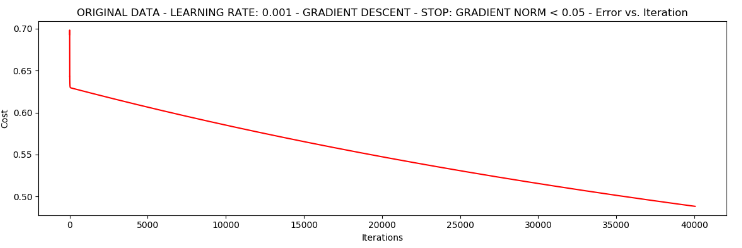梯度下降: 对theta1, theta2, theta3 分别求最快梯度下降的方向,然后根据给定的学习率,进行theta1, theta2, theta3的参数跟新
假定目标函数 J(theta) = 1/2m * np.sum(h(theta) - y)^2 / len(X)
梯度下降的策略分为3种,
批量梯度下降: 每次迭代输入全部的数据, 效果好,但耗时
随机梯度下降: 每次输入一个样本,时间快,迭代效果差
小批量梯度下降:每次输入部分数据,效果好,时间适中,一般都是16, 32, 64
逻辑回归: 是一种典型的二分类,也可以是多分类,主要在于cost的定义
逻辑回归的概率似然函数: h(theta)**y * (1-h(theta)) ** (1-y)
逻辑回归的对数似然函数 l(theta) = 1/ m * np.sum(y*logh(theta) - (1-y)*log(1-h(theta))) # 及损失函数
依据theta对损失函数进行求导,求出梯度下降的方向,用于跟新参数
grad = 1/m np.sum(h(theta) - y) * xj xj表示的是一列特征
theta = theta - grad
接下来进行代码分析
需要完成的函数
主要函数
sigmoid #将数值映射为概率
model # 构造h(theta) 即 sigmoid(np.dot(X, theta.T))
cost # 计算损失值及对数似然函数 1/ m * np.sum(-y*logh(theta) - (1-y)*log(1-h(theta)))
gradient # 用于计算梯度 grad = 1/m np.sum(h(theta) - y) * xj
descent # 用于进行参数更新
runExpe # 进行画图操作
predict # 进行结果预测
次要函数
shuffledata # 用于进行数据清洗
StopCriter # 停止情况判断
代码:
import numpy as np import pandas as pd import time import matplotlib.pyplot as plt pdData = pd.read_csv('data/LogiReg_data.txt', header=None, names=['exam1', 'exam2', 'admitted']) # 插入一列全1的数据, 为了和theta0进行匹配 pdData.insert(0, 'ones', 1) # 将数据转换的为numpy形式 orig_data = pdData.as_matrix() # 获得列的维度 cols = orig_data.shape[1] # 分出样本 X = orig_data[:, :cols-1] # 分出标签 y = orig_data[:, cols-1:] # 初始化theta theta = np.zeros([1, 3]) # 定义sigmoid函数 def sigmoid(z): return (1 / (1 + np.exp(-z))) # 定义H(theta) def model(X, theta): return sigmoid(np.dot(X, theta.T)) # 定义损失函数即对数似然函数 1/ m * np.sum(-y*logh(theta) - (1-y)*log(1-h(theta))) def cost(X, y, theta): left = np.multiply(-y, np.log(model(X, theta))) right = np.multiply((1-y), np.log(1-model(X, theta))) return np.sum(left - right) / len(X) # 定义数据洗牌的函数 def shuffle_data(data): # 进行数据洗牌 np.random.shuffle(data) # 分离出X和y cols = data.shape[1] X = data[:, :cols-1] y = data[:, cols-1:] return X, y # 定义停止条件的函数 Stop_iter = 0 Stop_cost = 1 Stop_grad = 2 def StopCriter(Stop_name, value, threshold): # 如果迭代条件是迭代次数,返回迭代比较的结果,真或者假 if Stop_name == Stop_iter: return value > threshold # 如果迭代条件是损失值,返回最后两个损失值之差,如果低于阈值,返回为真 elif Stop_name == Stop_cost: return value[-2] - value[-1] < threshold # 如果迭代条件是梯度下降的方向向量,返回的是梯度下降方向向量的模,如果低于阈值,则返回为真 elif Stop_name == Stop_grad: return np.linalg.norm(value) < threshold # 用于计算梯度下降方向的向量 grad = 1/m np.sum(h(theta) - y) * xj def gradient(X, y, theta): # 初始化梯度值 grad = np.zeros_like(theta) # 计算误差 ravel()函数将(100, 1)转换为(100, ) error = (model(X, theta) - y).ravel() # 计算每一个方向上的梯度方向 for j in range(X.shape[1]): term = np.multiply(error, X[:, j]) grad[0, j] = np.sum(term) / len(X) return grad # 在梯度方向上进行theta的参数更新 def descent(data, theta, batchsize, Stop_name, threshold, alpha): # 数据进行洗牌 X, y = shuffle_data(data) k = 0 # 获得损失值函数 costs = [cost(X, y, theta)] # 迭代次数 i = 0 # 初始时间 init_time = time.time() # 循环 while True: # 获得batchsize的样本 batch_x, batch_y = X[k:k+batchsize], y[k:k+batchsize] # 更新k k = k + batchsize # 如果k大于样本数,置0,重新获得洗牌后的X和y if k >= X.shape[0]: k = 0 X, y = shuffle_data(data) # 计算梯度方向 grad = gradient(batch_x, batch_y, theta) # 更新参数 theta = theta - alpha * grad # 重新计算损失值 costs.append(cost(X, y, theta)) i = i + 1 # 根据迭代的条件获得当前的value值 if Stop_name == Stop_iter:value = i elif Stop_name == Stop_cost: value=costs elif Stop_name == Stop_grad: value=grad # 将value值输入,与阈值进行条件比较,满足即跳出循环 if StopCriter(Stop_name, value, threshold): break # 返回 return data, theta, i, batchsize, Stop_name, threshold, alpha, time.time() - init_time, costs # 进行画图操作 def runExpe(data, theta, batchsize, Stop_name, threshold, alpha): data, theta, i, batchsize, Stop_name, threshold, alpha, dur, costs = descent(data, theta, batchsize, Stop_name, threshold, alpha) name = "Original" if (data[:, 1] > 2).sum() > 1 else "Scaled" name += " data - learning rate: {} - ".format(alpha) if batchsize == n: strDescType = "Gradient" elif batchsize == 1: strDescType = "Stochastic" else: strDescType = "Mini-batch ({})".format(batchsize) name += strDescType + " descent - Stop: " if Stop_name == Stop_iter: strStop = "{} iterations".format(threshold) elif Stop_name == Stop_cost: strStop = "costs change < {}".format(threshold) else: strStop = "gradient norm < {}".format(threshold) name += strStop print("***{} Theta: {} - Iter: {} - Last cost: {:03.2f} - Duration: {:03.2f}s".format( name, theta, iter, costs[-1], dur)) fig, ax = plt.subplots(figsize=(12, 4)) ax.plot(np.arange(len(costs)), costs, 'r') ax.set_xlabel('Iterations') ax.set_ylabel('Cost') ax.set_title(name.upper() + ' - Error vs. Iteration') return theta # 预测函数 def predict(X, theta): # 代入h(theta) 即model中进行样本预测 pre_y = model(X, theta) # 概率大于0.5的,输出为1, 小于0.5的输出为0 pre_y[pre_y >= 0.5] = 1 pre_y[pre_y < 0.5] = 0 # 返回预测结果的向量 return pre_y # 表示样本的总个数 n = 100 # 获得迭代好以后的theta theta = runExpe(orig_data, theta, 100, Stop_grad, 0.05, alpha=0.001) # 进行数据归一化操作 import sklearn.preprocessing as pp scale_data = orig_data.copy() # 对第二列和第三列数据进行归一化操作 scale_data[:, 1:3] = pp.scale(scale_data[:, 1:3]) # 获得预测结果的向量 pre_y = predict(X, theta) # 将预测结果与真实结果进行比较,返回0和1的数组,正确是1,错误是0 correct_array = np.array(pre_y == y, dtype=int) # 准确率就是计算正确和错误的平均值 accurracy = correct_array.mean() print(accurracy)

迭代次数与损失值cost的作图